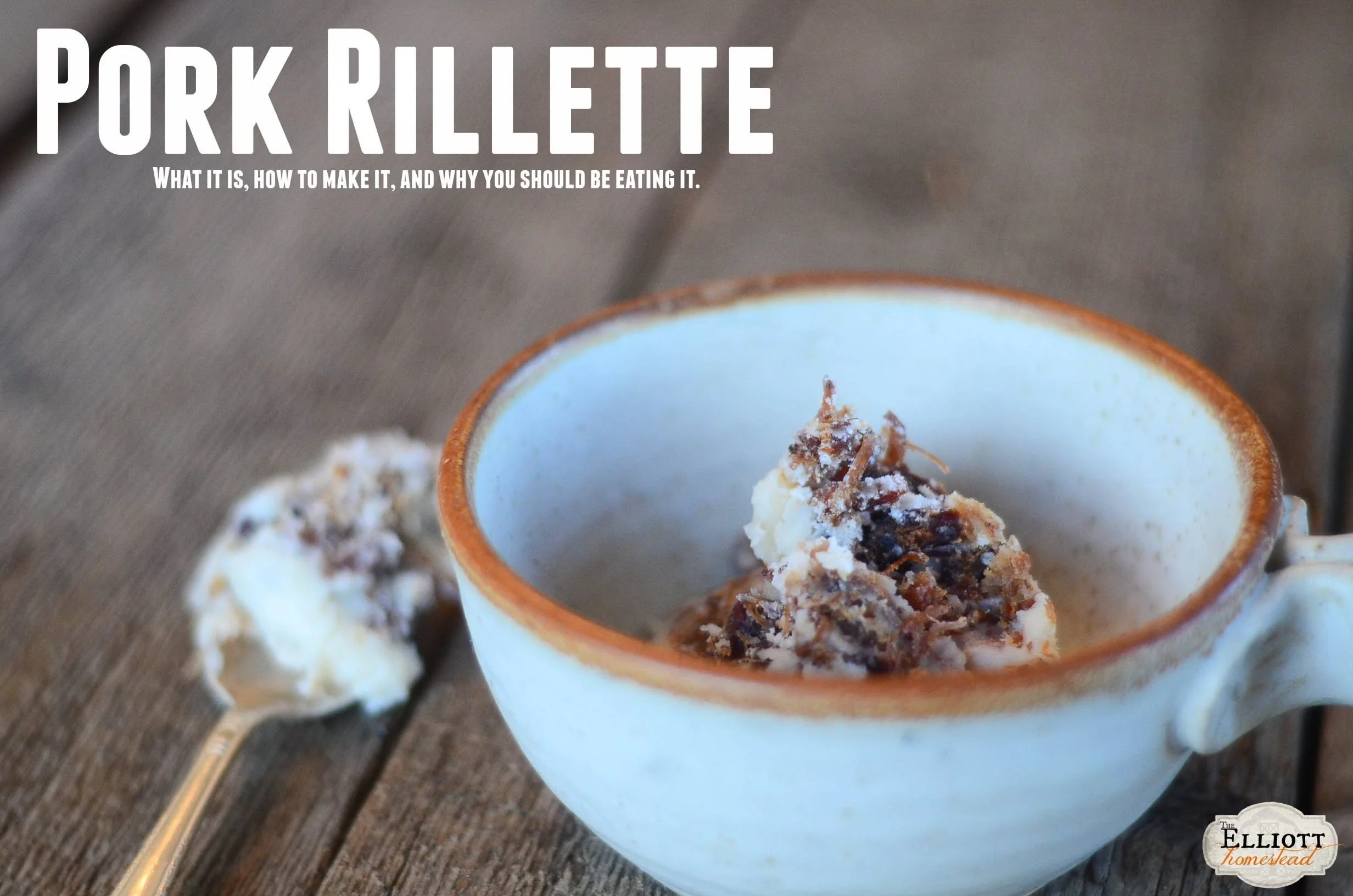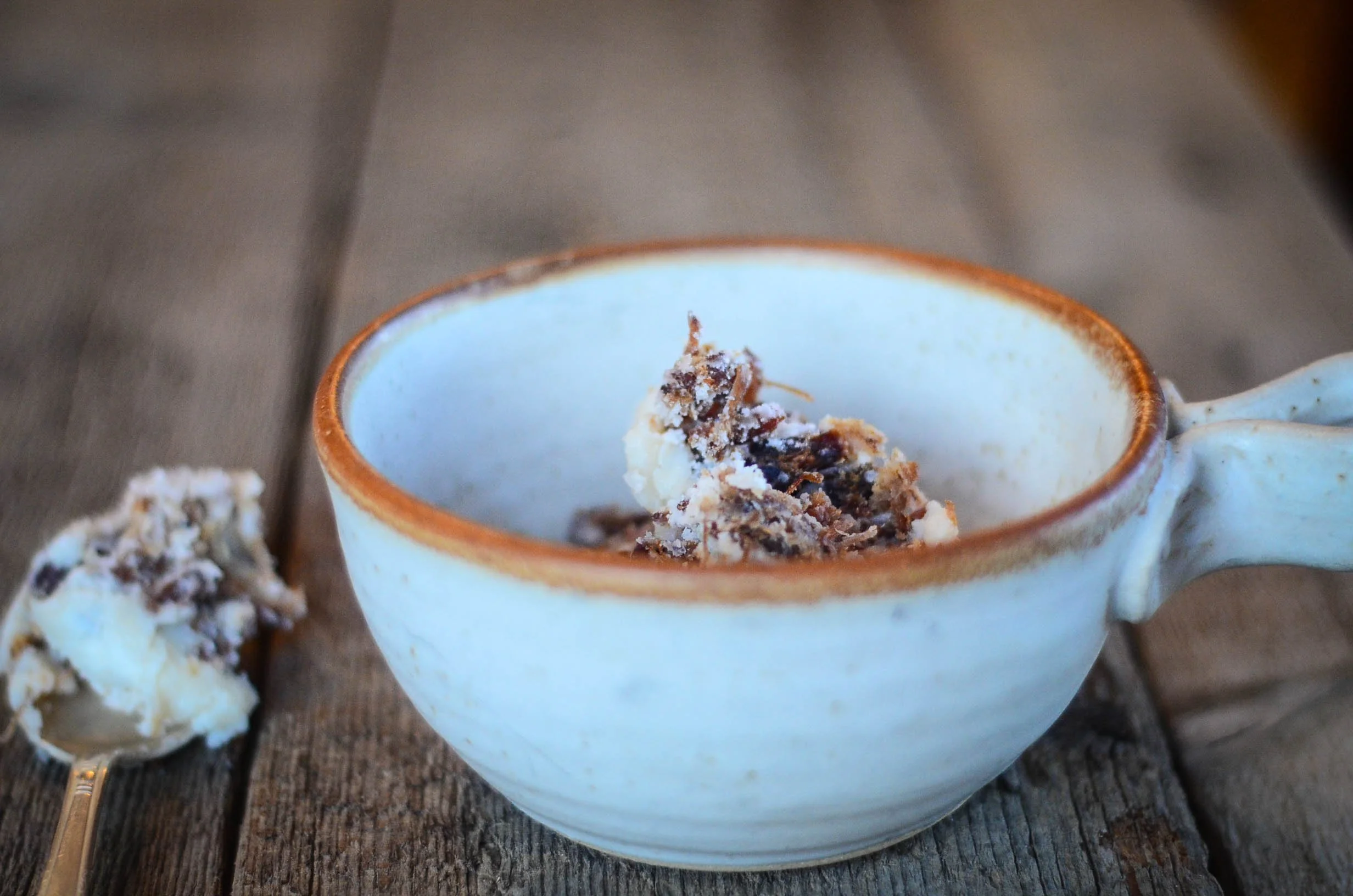Pork Rillette
Pork. Porky, pork, pork. It's on my mind. And it's in my belly. And in my freezer. And in my refrigerator. And hanging in my kitchen. After butchering the pigs last week, well, pork became the meat of choice here on the homestead. Thanks to the Farmstead Meatsmith, Brandon, who came to help us butcher the pigs, I was able to utilize a lot of the cuts that would otherwise be considered “waste.” Brandon is a big advocate for nose-to-tail eating, and I love that philosophy. Even the parts I couldn't (and/or didn't) want to utilize as food myself, I was able to utilize as food for the dog. That's a win-win, baby.
One of the most striking bits of “waste” that is produced in commercial hog butchering is just a variety of scraps. A little snip snip from here. A little snip snip from there. All still full of valuable fat and calories. One of the greatest ways to utilize these “scraps” is to make what Brandon calls “rillette.” Rillette is simply a means of cooking pork in its own fatty goodness — it is then salted and preserved in its own fat to be served at room temperature (most often smeared on a piece of fresh, crusty bread). That is, bits of pork meat cooked in its own fat. That is, one of the fattiest, richest, most delicious ways to eat pork. That is, valuable calories and food that shan't be wasted. I SHAN'T WASTE THE PORK, I SAY! I worked hard for every single bit of meat and fat on those pigs, and I'll be danged if any of it is going to not be utilized to the max. Thus, I made Rillette. And thus, I think you should make it to.
But Shaye? I don't have a pig to butcher, and thus, I don't have any bits of pork scraps waiting for their culinary destiny! But reader, don't worry. Because I guarantee there is a butcher nearby you who does. And I bet he'll sell you the itty bits of pork scraps for next to nothin’. And if he won't, maybe a nearby hog farmer will.
As we first munched on this rillette, Stuart and I began talking about the value of such a product “back in the day.” If our survival were dependent completely on the food that we were able to produce, something of this caloric richness would be incredibly valuable. In fact, pigs were originally chosen specifically for their ability to put on fat because of its caloric value. Fat is more nutrient-dense than meat and thus, more valuable as “survival” food. It's silly when you think about how far we've come from this line of thinking, often opting for super-lean, skinless, tasteless chicken meat because it's “healthier.” What an arrogant thought, really, to think the rest of the animal has less value. A chicken is much more than breast meat, and a pig is much more than pork chops. There is incredible wealth in its fat, and utilizing and appreciating that adds such a wonderful value to the animal, overall.
Fats from animal and vegetable sources provide a concentrated source of energy in the diet; they also provide the building blocks for cell membranes and a variety of hormones and hormonelike substances. Fats as part of a meal slow down absorption so that we can go longer without feeling hungry. In addition, they act as carriers for important fat-soluble vitamins A, D, E and K. Dietary fats are needed for the conversion of carotene to vitamin A, for mineral absorption and for a host of other processes. Source
Fat's where it's at, baby.
What can I say? I made a fresh loaf of bread! And I just couldn't pass up the opportunity to smear that fresh bread in pig fat. Good Lord, it's delicious. Especially with those little bits of browned pork in it. And smeared on bread with a few fresh tomato slices as a sandwich? Fu-get-about-it.Waste? I say not. Delicious browned pork meat, gently cooked in its own lard? I say yes. Yes, yes, a thousand times yes.
Pork Rillette Recipe
Ingredients:
Pork scraps (a combination of meat and fat of any ratio will do)
Sea salt and freshly ground black pepper (to taste)
Instuctions:
Cut the pork scraps into 1-2″ pieces. Add them into the Dutch oven and turn the heat to low. Cover with the lid.
Let the pork slowly cook and melt, stirring as often as you remember to. We’re not looking to sear or brown the meat. Just gently, slowly, patiently, let the pork melt and cook on its own.
Once the pork bits are nicely browned (I did about 3 pounds of scraps and it took about 20 hours), turn the heat off, and gently remove the bits of meat from the Dutch oven. I simply used a strainer to skim through the fat. Place the meat bits into a large bowl and season to taste with salt and pepper. Give it a little extra salt, as you’ll be eating it at room temperature.
Use two forks to gently shred the bits of meat up, breaking up any large chunks.
Using a set of tongs, scoop the meat bits into a large mason jar, pushing down with the tongs to help release any air bubbles and condense the meat. Once all the meat is added, pour the melted fat left in the Dutch oven over the top of the meat, covering it by at least 1/2″.
Place a two-piece lid onto the mason jar and immediately stick the jar into the refrigerator. This will cause the jar to seal as it cools (essentially ‘hot-packing’ the meat).
Once the jar has sealed, you can store the rillette in your refrigerator for many months, or you can eat it the very next day. Like I did.




